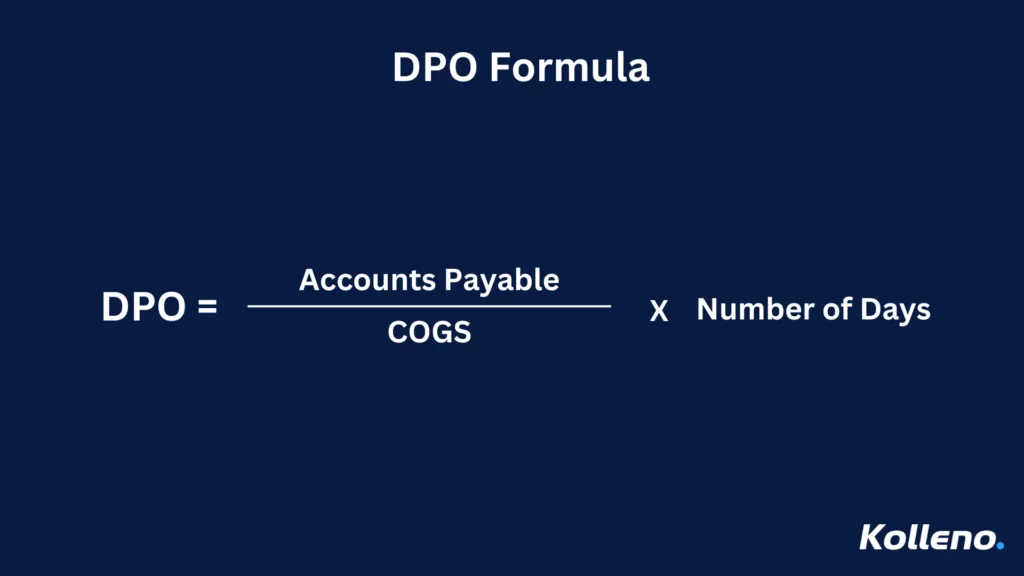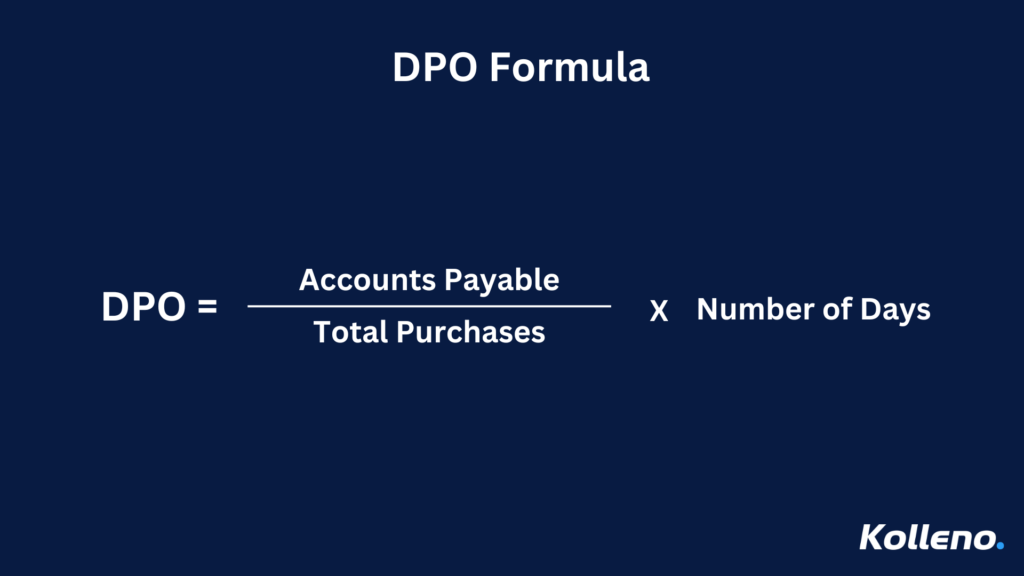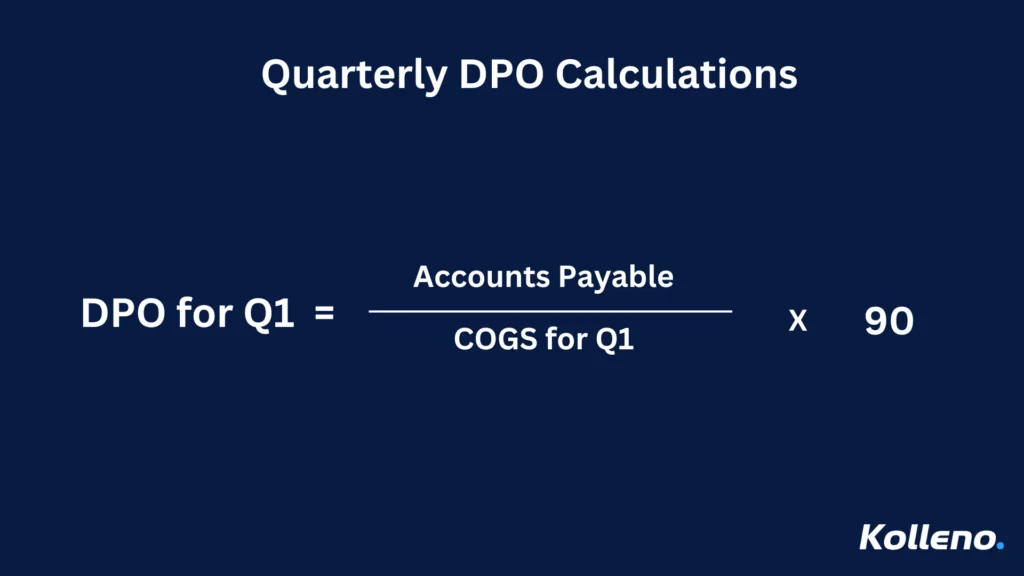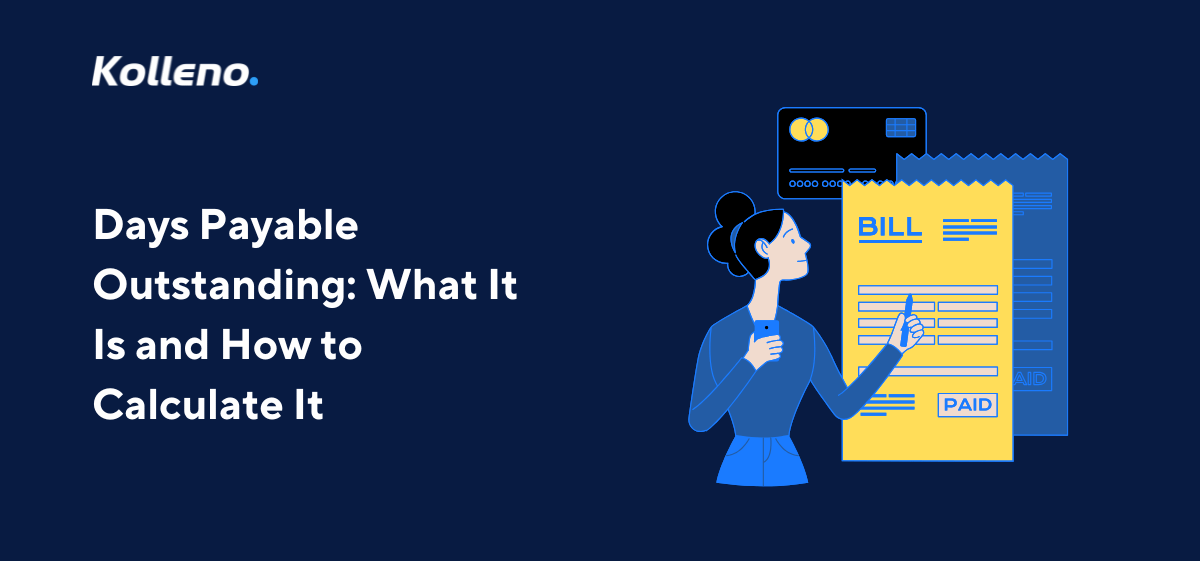When evaluating a company’s financial health, one crucial metric often overlooked is Days Payable Outstanding (DPO). Understanding Days Payable Outstanding (DPO) is important. It shows how well a business manages its cash flow. Knowing how to calculate DPO can give insights into a company’s efficiency. This guide will break down DPO in detail, so you can confidently analyze this key performance indicator (KPI).
What Is Days Payable Outstanding (DPO)?
Days Payable Outstanding (DPO) shows how long a company usually takes to pay its suppliers. This happens after receiving goods or services. It’s an important metric in working capital management because it reflects a company’s ability to efficiently manage its accounts payable without jeopardizing supplier relationships.
In simpler terms, DPO tells you the number of days a company holds onto its cash after receiving an invoice from its suppliers.
By maintaining an optimal DPO, a company can balance its cash flow while fostering healthy relationships with its suppliers. Businesses that understand and monitor their DPO gain an edge in managing financial operations efficiently.
Why Is DPO Important?
DPO has significant implications for cash flow, operational efficiency, and supplier management. A higher DPO indicates that the company is taking longer to pay its suppliers, which may improve short-term cash flow. However, delaying payments too much could strain supplier relationships. Conversely, a lower DPO might indicate prompt payments, which can enhance supplier trust but may limit the company’s cash flexibility.
Here are some specific reasons DPO is critical:
- Cash Flow Optimization: Helps businesses retain cash for longer periods, providing flexibility for reinvestments or operational needs.
- Supplier Relationship Management: A balanced DPO ensures suppliers are paid on time, fostering trust and continuity in the supply chain.
- Credit Utilization: Effective use of credit terms can significantly boost working capital.
How to Calculate Days Payable Outstanding (DPO)
Calculating DPO involves a straightforward formula that requires three key figures:
- Accounts Payable (AP): The total amount owed to suppliers at a specific time.
- Cost of Goods Sold (COGS): The direct costs of producing goods sold by the company during a specific period.
- Number of Days: The time frame for which DPO is being calculated (usually 365 days for annual data).
Here’s the formula:

Step-by-Step Guide to Calculate DPO
Let’s break down the calculation with an example:
Example:
- Accounts Payable: $50,000
- COGS: $300,000
- Number of Days: 365
- Divide Accounts Payable by COGS: 50,000/ 300,000=0.1667
- Multiply the result by the Number of Days: 0.1667×365= 60.83
DPO = 60.83 days
This means the company takes approximately 61 days to pay its suppliers.
By consistently calculating and monitoring DPO, businesses can track trends and identify areas for improvement in their financial processes.
Formula Variations for DPO
While the standard formula is widely accepted, variations might be used depending on the context or the financial data available. For instance:
- Using Total Purchases Instead of COGS: Some companies prefer to use total purchases (goods and services) rather than COGS for calculating DPO.

Quarterly or Monthly DPO Calculations:
- For shorter periods, such as a quarter or month, replace the number of days with 90 or 30, respectively.

Understanding these variations allows businesses to adapt the calculation to their specific needs or reporting periods.
Interpreting DPO: What’s a Good Number?
The ideal DPO varies by industry and company size. For instance:
- Retailers and Consumer Goods Companies: Often have shorter DPOs (e.g., 30-45 days) due to the need to maintain strong supplier relationships.
- Manufacturers and Large Enterprises: May have longer DPOs (e.g., 60-90 days) because they have leverage to negotiate better payment terms.
High vs. Low DPO: Pros and Cons
High DPO
- Advantages:
- Frees up cash for short-term investments or operational needs.
- Indicates strong negotiation power with suppliers.
- Disadvantages:
- Can strain supplier relationships.
- Might signal liquidity issues if not managed properly.
Low DPO
- Advantages:
- Builds stronger supplier trust and partnerships.
- Reflects efficient cash flow management.
- Disadvantages:
- Reduces cash available for other uses.
- Might indicate poor utilization of credit terms.
Benchmarking DPO in Different Industries
Here are some average DPO ranges by industry:
- Retail: 30-45 days
- Manufacturing: 50-70 days
- Technology: 60-90 days
- Healthcare: 40-60 days
Benchmarking your DPO against industry standards can help identify inefficiencies or opportunities for improvement.
Real-World Applications of DPO
1. Cash Flow Optimization
A company with a high DPO can utilize the delayed payment period to reinvest cash into growth initiatives or pay down debt. For example, a retail company might use the extra cash to fund seasonal inventory purchases.
2. Supplier Negotiations
Understanding DPO helps companies evaluate whether their payment terms align with industry standards. Businesses with strong supplier relationships can often negotiate longer payment terms to improve DPO.
3. Benchmarking Against Competitors
By comparing DPO against industry peers, a company can assess its financial efficiency. A significantly higher or lower DPO than competitors might signal operational inefficiencies.
4. Assessing Financial Health
Creditors and investors often analyze DPO alongside other metrics like Days Sales Outstanding (DSO) and Days Inventory Outstanding (DIO) to understand the company’s cash conversion cycle (CCC).
Factors Influencing Days Payable Outstanding (DPO)
1. Industry Practices
Industry norms play a significant role in determining average DPO. Different sectors have distinct supply chain dynamics and expectations for payment terms. For example:
- Construction: Payment terms can often exceed 90 days due to complex supply chains and project-based invoicing. Contractors may receive payments only after project milestones are completed.
- Healthcare: Providers often deal with a mix of immediate and delayed payments, as insurers and government agencies impact cash flow.
- Retail: Retailers frequently operate with shorter payment terms (e.g., 30–45 days) since maintaining strong supplier relationships ensures smooth inventory replenishment.
Key Consideration:
Companies should benchmark their DPO against industry averages to assess their financial efficiency and maintain competitive supplier terms.
2. Negotiation Power
Larger companies often benefit from economies of scale, granting them leverage to negotiate extended payment terms. Suppliers may agree to these terms because larger companies:
- Provide high-volume, consistent business.
- Represent minimal risk in terms of payment default.
Small Businesses and Negotiation:
While smaller companies may lack the same leverage, they can still negotiate favorable terms by demonstrating reliability and maintaining strong relationships with suppliers.
Example:
A multinational supermarket chain like Walmart may negotiate payment terms of 90 days or more due to its massive purchasing power. In contrast, a local grocery store might have less flexibility and shorter payment terms of 30 days.
3. Financial Health
Companies in a precarious financial position often extend DPO as a short-term strategy to preserve cash. However, this tactic can have long-term consequences:
- Negative Impact: Suppliers may lose trust and demand stricter terms or penalties, reducing operational flexibility.
- Warning Sign: Persistent increases in DPO, coupled with rising Accounts Payable, could signal liquidity problems to investors and creditors.
Best Practice:
Monitor DPO in the context of broader financial health. If extending DPO, communicate proactively with suppliers to avoid straining relationships.
4. Supply Chain Dynamics
Supply chain criticality directly impacts DPO decisions. Companies may choose shorter payment terms for strategic suppliers who:
- Provide essential raw materials or services.
- Operate in industries with low competition or tight capacity.
Example:
A car manufacturer may pay its chip supplier sooner to secure uninterrupted access, as semiconductor shortages can disrupt production.
Collaboration Benefits:
Companies can establish mutually beneficial agreements, such as offering early payments for discounts or prioritizing faster payments during periods of high demand.
5. Seasonal Trends
DPO may fluctuate throughout the year, particularly in industries affected by seasonality. For example:
- Retail: Payment terms may shorten during the holiday season when inventory turnover increases.
- Agriculture: Payments might align with harvest and planting cycles.
Planning for Seasonal Variations:
Companies should account for these trends when setting DPO targets, ensuring they have enough liquidity during peak seasons.
How to Improve Days Payable Outstanding (DPO)
Optimizing DPO requires a balance between extending payment terms for cash flow benefits and maintaining supplier relationships. Below are detailed strategies to improve DPO:
1. Negotiate Better Terms
To negotiate favorable terms:
- Build Relationships: Strengthen ties with suppliers by showing consistent reliability.
- Leverage Data: Use past performance metrics, such as early payment histories, to negotiate longer terms.
Advanced Tip:
Propose tiered payment terms based on volume. For example, extend payments for larger orders while maintaining shorter terms for smaller ones.
2. Streamline Accounts Payable Processes
Inefficiencies in accounts payable can result in missed opportunities to align payments with optimal DPO goals. Automation tools such as Tipalti can:
- Reduce manual errors in invoice processing.
- Ensure accurate tracking of payment schedules.
- Identify potential savings through early payment discounts.
Recommended Tools:
3. Monitor Cash Flow Closely
Aligning DPO with cash flow projections ensures a company doesn’t overextend itself. Regular cash flow monitoring allows businesses to:
- Identify peak liquidity periods.
- Adjust payment schedules accordingly.
- Avoid late payment penalties.
Tip:
Use dynamic cash flow models that factor in DSO, DIO, and DPO to provide real-time insights.
4. Use Supplier Financing
Supplier financing, also known as reverse factoring, can help improve DPO without straining relationships. Here’s how it works:
- Suppliers receive early payments from a financing institution.
- The company retains its original payment terms, improving DPO.
Example:
A fashion retailer using supplier financing can pay invoices in 90 days while suppliers receive their payments within 10 days, creating a win-win scenario.
Common Mistakes to Avoid with DPO
1. Focusing Solely on High DPO
While a high DPO may indicate strong cash flow management, excessively delaying payments can harm supplier relationships, resulting in:
- Lost discounts.
- Higher costs due to supplier penalties.
- Damage to the company’s reputation in the industry.
Balance is Key:
Aim for a DPO that aligns with your cash flow needs and industry standards.
2. Ignoring Industry Benchmarks
Industry standards provide a clear context for interpreting DPO. A significantly higher or lower DPO than peers can signal inefficiencies or financial distress.
Actionable Tip:
Compare DPO to competitors by reviewing annual reports or using financial benchmarking tools.
3. Overlooking Cash Flow
Even a high DPO won’t benefit a company if cash flow isn’t managed effectively. A mismatch between incoming and outgoing cash flows can lead to liquidity crises.
Proactive Steps:
Align DPO with your operating cycle, ensuring cash inflows cover outgoing obligations.
4. Neglecting Supplier Communication
Transparent communication is crucial for maintaining trust with suppliers. Informing suppliers about payment schedules and delays helps mitigate conflicts and maintains goodwill.
By delving deeper into these areas, this expanded section provides actionable insights and advanced considerations for managing and improving Days Payable Outstanding. It ensures businesses not only understand the metrics but also leverage them strategically for sustained growth.
Frequently Asked Questions about DPO
1. What is a good Days Payable Outstanding ratio?
A good DPO depends on your industry and operational needs. Generally, a DPO that aligns with industry averages is considered optimal.
2. Can DPO be negative?
No, DPO cannot be negative. A DPO of zero would imply immediate payment upon receipt of an invoice.
3. How does DPO affect working capital?
A higher DPO improves working capital by delaying cash outflows, while a lower DPO reduces working capital by paying suppliers more quickly.
Final Thoughts
Understanding what Days Payable Outstanding is and how to calculate Days Payable Outstanding is critical for businesses aiming to optimize cash flow and supplier relationships. DPO is not just a metric—it’s a strategic tool that, when used effectively, can enhance a company’s financial stability and operational efficiency.
By carefully managing your DPO and benchmarking it against industry standards, you can strike the perfect balance between maintaining healthy supplier relationships and optimizing cash flow. Whether you’re a business owner, CFO, or financial analyst, mastering DPO can significantly contribute to your organization’s success.
With Tipalti (Accounts Payables solution) and Kolleno (Accounts Receivable solution) integrated into ERP, you can automate both your accounts payable and accounts receivable processes, saving over 2 hours of manual work each day. This streamlined approach not only frees up valuable time but also enhances accuracy, reduces errors, and provides a real-time view of your cash flow—all contributing to a stronger financial position for your business.
Download our one-pager to discover the full potential of this integration and how it can optimize your financial operations! Download it here.
- What Is Days Payable Outstanding (DPO)?
- Why Is DPO Important?
- How to Calculate Days Payable Outstanding (DPO)
- Interpreting DPO: What’s a Good Number?
- Real-World Applications of DPO
- Factors Influencing Days Payable Outstanding (DPO)
- How to Improve Days Payable Outstanding (DPO)
- Common Mistakes to Avoid with DPO
- Frequently Asked Questions about DPO
- Final Thoughts



